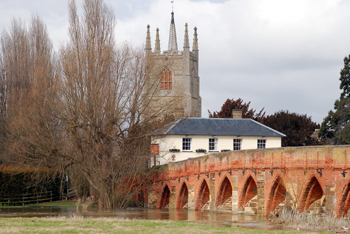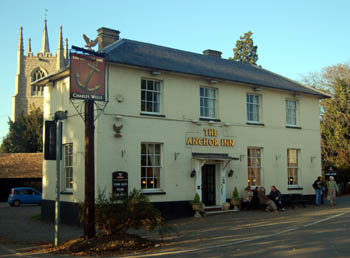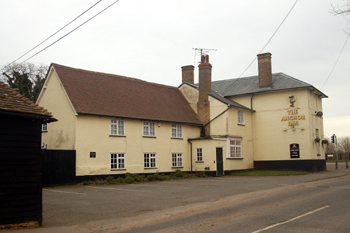The Anchor Inn Great Barford

The Anchor Inn, Great Barford Church and Barford Bridge March 2010
The Anchor Inn, High Street, Great Barford
The Anchor was listed by the former Department of Environment in July 1964 as Grade II, of special interest. The department dated the property to about 1700 with parts dating to the 19th century. The earlier rear wing is of colour washed roughcast over a timber frame with a clay tile roof and has two storeys. The 19th century block is of colour washed brick with a hipped slate roof with wide eaves. The listing comments: “Listed for group value”.
It is possible, and has been suggested, that the Anchor had previously been called the Black Bull. Bedfordshire Historic Records Society volume 24, published in 1946, has transcriptions of evidence given concerning the navigation of the River Great Ouse. On Thursday 19th September 1689 statements were taken from a number of people at “the sign of the Black Bull in Great Barford, being the house of Edmond Ward”. Those giving evidence were: Thomas Fullforth of Great Barford, tailor; John Smith of Blunham, fisherman; Amy Levett of Great Barford; Richard Smith of Blunham, husbandman; Saba Poole of Great Barford; Anne Garnett of Great Barford; Elizabeth Wye of Great Barford; John Gill of Great Barford, collar maker; Thomas Parrin of Mogerhanger, husbandman; Richard Stocker of Eaton Socon, gentleman; John Garnett of Great Barford, coal seller; Anne Waldocke of Great Barford; Robert Man of Willington, labourer; Edmund Ward himself, the innholder. The site of today’s Anchor would certainly be a suitable place for such a hearing. The Quarter Sessions were held at the inn in 1738 [QSM Volume 7, page 26].
Perhaps the most interesting evidence comes from around 1820 when the renewal of the licence of the public house was refused to innholder James Baker. Baker himself petitioned the justices at Bedford [X290/14] stating that a licence had been granted to Benjamin Jefferies 1818 to keep “a new erected public-house, the Anchor”. Jefferies had “greatly enlarged it and fitted it up as a respectable and commodious inn”. Baker had became tenant in 1819. In support of his application, Baker stated that the inclosure commissioners met at the inn, and that it was on the turnpike road from Oxford to Cambridge. Baker and his ancestors have been licensed victuallers in Great Barford for "near a century".
The trustees of the now dead Benjamin Jefferies stated [X290/15] that Jefferies “began to build the Anchor, and afterwards enlarged his views in view of the stages and other traffic daily passing”. They stated that Baker, “who has "or a series of years conducted a public house in Great Barford with credit" became tenant. The vicar, churchwardens, overseers and substantial householders echoed the trustees’ petition [X290/16]. Evidently Baker was successful because he remained licensee of the Anchor until his death in 1848. He had been victualler of the White Hart in 1811 when the minutes of the Hundred Court note that the meeting was held in his house, called the White Hart. When Baker moved to the Anchor the Hundred Court moved with him and met at that hostelry instead.
This evidence seems to contradict the opinion of the Department of Environment, which dated the inn to about 1700 which, give of take twenty years, would allow for it being the Black Bull of 1689. Perhaps either the Black Bull had either closed before Benjamin Jefferies built the Anchor or he renamed the inn after rebuilding it. He may have left the original rear wing (the old Black Bull) as his private accommodation and simply added a new element to the building at the front and used this as the Anchor, a suitably watery reference to an inn benefiting from river traffic. Without a set of title deeds it is doubtful if this puzzle can be resolved.
A fire insurance policy for the Anchor from 1824 survives [X290/18]. The policy was taken out with Norwich Union Fire Insurance Society for £800 by Benjamin Jefferies, evidently heir to the previous Benjamin Jefferies. The buildings covered are described as “Six hundred and fifty pounds on a Dwellinghouse, brick, timber and tile or slate with Offices adjoining situate at Great Barford aforesaid called the Anchor Inn in tenure of James Baker and one hundred and fifty pounds on 1 Brewhouse, Stable, Coachhouse, Piggeries and Cowhouse adjoining, timber and tiled”.
When James Baker died in 1848 Benjamin Jefferies next leased the Anchor to Robert Parker of Bromham Hall for £40 per annum [X290/24]. In 1862 he leased the Anchor to Joseph Allen Piggot of Bedford, common brewer at the same rent [X290/25]. Benjamin Jefferies died in 1862 [WL1000/1/GB/1/1] and devised the Anchor to his wife Edith, who died in 1867, then to his son Robert Ayres Jefferies. In 1869 Robert Ayres Jefferies leased the Anchor to Joseph Allen Piggott at the same rent of £40 [X290/26]. Piggott, as a brewer, had a number of public houses and sublet them to tenants, John Sabey at the Anchor until at least 1864. Piggott had been in partnership with Henry Collings Wells since 1851 but bought his partner out in 1862, trading alone until 1875 when the business was bought by Charles Wells [WL73].
Robert Ayres Jefferies made his will in 1876, devising the Anchor to trustees for sale [WL1000/1/GB/1/1]. He died in 1878 and in 1881 the Anchor was duly put up for sale by auction. the sale particulars [WL1000/1/GB/1/3] described it as follows:
“THE ANCHOR INN”
WITH EXCELLENT PREMISES
Occupying a first-class position in the populous village of Great Barford, near to the Bridge and at the junction of the Roxton and Blunham Roads
The House and Premises are substantially built, and in good condition, with accommodation for a large Business; and being pleasantly situated near the River, where capital Fishing may be had, is the frequent resort of Visitors during the Season
THE HOUSE
Contains 9 Bedchambers, 2 large Parlours, Bar, Taproom, capital Cellars, Kitchen, Pantry, and the usual Domestic Offices
THE OUT-PREMISES
Consist of a large Brewhouse, 2 Barns, Stabling for 16 Horses and Coach-house
The Anchor was bought by Bedford brewer Thomas Jarvis for £935 [WL1000/1/GB/1/6]. Jarvis' company was bought by rival Bedford brewer Charles Wells Limited in 1910.
The Rating and Valuation Act 1925 specified that every building and piece of land in the country was to be assessed to determine its rateable value. Most of Bedfordshire was valued in 1927 and the valuer visiting the Anchor [DV1/C156/37] found it occupied by Frederick William Lawrence who paid rent of £18 per annum (“Been here 27 years in August next”).
Accommodation comprised a bar, tap room, dining room, tap cellar and underground cellar (“not used”). A stable for three horses, a coach house and a further stable for two horses (“not sublet, very good stabling”) lay outside along with a garage, urinal and earth closet. Private accommodation consisted of a kitchen with a range, sink, pump and copper for heating water, a sitting room with a grate and a boxroom and five bedrooms upstairs (“3 of them letting bedrooms, last time a visitor 2 weeks ago”).
Two half barrels and two quarter barrels lay in the cellar when the valuer visited and trade was a barrel and a quarter of beer per month in the summer, due, no doubt to the attraction of the river, and about half a barrel per month for the rest of the year. Four dozen half pint bottles of beer per week were sold and a gallon of spirits per month as well as tobacco sales worth fifteen shillings per week and a tin of cigars per month. Average takings were £5 per week.
The valuer commented “Excellent house with good stabling. I think tenant underestimates trade”. He also commented: “Publican a morose sort of chap but tries to be sociable”.
In 1936 a new bathroom and w. c. were added to the private accommodation at the Anchor [RDBP2/857]. In 1947 new public toilets were built and alterations made to the cellar [RDBP3/815].

The Anchor Inn October 2007
List of References
- Bedfordshire Historical Records Society Vol.24: depositions regarding navigation of River Great Ouse taken at inn: 1689;
- QSM Vol.7 p.26: Quarter Sessions held at inn: 1738;
- WG6/14: Hundred count held at public house: 1811-1814;
- X290/14-16: petitions regarding refusal of the magistrates to renew the licence: 1818-1820;
- CLP13: Register of Alehouse Recognizances: 1822-1828;
- X290/17-21: fire insurance policy and three receipts: 1824-1827;
- X290/237-241: bills for Rent Day dinners: 1834-1844;
- X290/22: bill for ale and entertainment: 1839-1847;
- X290/23: statement of accounts: 1847;
- X290/24: lease: 1848;
- CRT130Rox6 and 11: auction sale of land at Chawston held at the Anchor: 1851;
- WL1000/1/GB/1/1: will of Benjamin Jefferies: 1860;
- X290/25: lease: 1862;
- X290/26: lease: 1869;
- WL73: sale particulars of the Bedford Brewery of Joseph Allen Piggott: 1875;
- WL1000/1/GB/1/1: will of Robert Ayres Jefferies: 1876;
- Z169/12: lantern slide of bridge and public house: c.1880-1950s
- WL1000/1/GB/1/3: sale particulars: 1881;
- WL1000/1/GB/1/6: conveyance to Thomas Jarvis: 1881;
- Z50/5/12: photograph of bridge and public house: C20;
- PSB9/1: Register of Alehouse Licences - Bedford Petty Sessional Division: 1903-1935
- Bedfordshire Inns & Pubs in Old Picture Postcards: view on front cover: c.1910;
- RDBP2/857: plans for additions: 1936;
- RDBP3/815: plans for alterations: 1947;
- Bedfordshire Magazine Vol.I.p.68: photograph of church, bridge and public house: 1947;
- PSB9/2: register of licenses: c.1955-1995;
- PCGreatBarford30/4: transfer of licence: 1975;
- PSBW8/3: Register of Alehouse Licences - Biggleswade and North Bedfordshire Petty Sessional Divisions: 1976-1980;
- WL722/98: "Pint Pot" in-house magazine of Charles Wells with note of award of Cask Marque to public house: 1999

The Anchor Inn March 2010
List of Licensees: note that this is not a complete list. Italics indicate licensees whose beginning and/or end dates are not known:
1679: Edmund Ward;
1818-1819: Benjamin Jefferies;
1819- March 1848: James Baker;
11 Mar 1848-4 Nov 1848: Mary Baker, widow;
4 Nov 1848 -1854 : Robert Parker
12 Apr 1856 - 6 Dec 1856: William Funnell;
6 Dec 1856 - 1 Jan 1859: James Gregory;
1 Jan 1859 - 1864: John Sabey;
1871-1876 Litchfield Northern;
1885-1890: Benjamin Robinson, plumber and glazier;
1903-1935: Frederick William Laurence;
1935-1936: Harry Lazenby;
1940: James H. Lazenby;
1962-1975: Joseph Murray Simpson;
1975-1985: Richard Geoffrey Churcher;
1986-1989: Alan Charles Plummer;
1989-1990: Reginald Knighton and Susan Lesley Keen;
1990-1992: Stephen Frederick Bushwell and Malcolm Doig Starling;
1992: Carole A.Hull and MalcolmDoig Starling;
1992-1994: Martyn Taylor;
1994: Ross Duncan Moorley;
1994: John Alexander Gordon Lloyd.